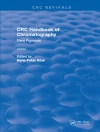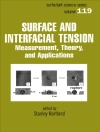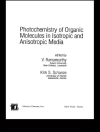Summarizing all the latest trends and recent topics in one handy volume, this book covers everything needed for a solid understanding of photochromic materials. Following a general introduction to organic photochromic materials, the authors move on to discuss not only the underlying theory but also the properties of such materials. After a selection of pplications, they look at the latest achievements in traditional solution-phase applications, including photochromic-based molecular logic operations and memory, optically modulated supramolecular system and sensors, as well as light-tunable chemical reactions. The book then describes the hotspot areas of photo-switchable surfaces and nanomaterials, photochromic-based luminescence/electronic devices and bulk materials together with light-regulated biological and bio-chemical systems. The authors conclude with a focus on current industrial applications and the future outlook for these materials.
Written with both senior researchers and entrants to the field in mind.
Tabla de materias
List of Contributors XI
1 Introduction: Organic Photochromic Molecules 1
Keitaro Nakatani, Jonathan Piard, Pei Yu, and Rémi Métivier
1.1 Photochromic Systems 1
1.1.1 General Introduction 1
1.1.2 Basic Principles 4
1.1.3 Photochromic Molecules: Some History 5
1.2 Organic Photochromic Molecules: Main Families 8
1.2.1 Proton Transfer 9
1.2.2 Trans–Cis Photoisomerization 12
1.2.3 Homolytic Cleavage 13
1.2.4 Cyclization Reaction 14
1.2.4.1 Spiropyrans, Spirooxazines, and Chromenes 14
1.2.4.2 Fulgides and Fulgimides 17
1.2.4.3 Diarylethenes 18
1.3 Molecular Design to Improve the Performance 20
1.3.1 Figures of Merit 20
1.3.2 Fatigue Resistance: Increasing the Number of Operating Cycles 21
1.3.3 Bistability: Avoiding Unwanted Thermal Back-Reaction in the Dark 23
1.3.3.1 Influence of Ethenic Bridge on the Thermal Stability of the B Form 24
1.3.3.2 Impact of the Heteroaryl Substituents on the Thermal Stability of the B Form 24
1.3.4 Fast Photochromic Systems: Reverting Back Spontaneously to the Colorless State in a Glance 25
1.3.5 Gaining Efficiency of the Photoreaction: the Example of Diarylethenes 26
1.4 Conclusion 31
Irradiation at a Specific Wavelength: Isosbestic Point 32
Case A: When the Thermal Back-Reaction is Negligible Compared to the Photochemical Reaction (Typically P-type) 33
Case B: When the Thermal Back-Reaction is More Efficient than the Photochemical B→A Reaction (Typically Type) 34
References 34
2 Photochromic Transitional Metal Complexes for Photosensitization 47
Chi-Chiu Ko and Vivian Wing-Wah Yam
2.1 Introduction 47
2.2 Photosensitization of Stilbene- and Azo-Containing Ligands 48
2.3 Photosensitization of Spirooxazine-Containing Ligands 51
2.4 Photosensitization of Diarylethene-Containing Ligands 54
2.5 Photosensitization of Photochromic N∧C-Chelate Organoboranes 63
2.6 Conclusion 65
References 66
3 Multi-addressable Photochromic Materials 71
Shangjun Chen, Wenlong Li, and Weihong Zhu
3.1 Molecular Logic Gates 71
3.1.1 Two-Input Logic Gates 71
3.1.2 Combinatorial Logic Systems 74
3.1.2.1 Half-Adder and Half-Subtractor 74
3.1.2.2 Keypad Locks 77
3.1.2.3 Digital Encoder and Decoder 82
3.2 Data Storage and Molecular Memory 84
3.2.1 Fluorescence Spectroscopy 85
3.2.2 Infrared Spectroscopy 90
3.2.3 Optical Rotation 92
3.3 Gated Photochromores 95
3.3.1 Hydrogen Bonding 95
3.3.2 Coordination 98
3.3.3 Chemical Reaction 99
References 105
4 Photoswitchable Supramolecular Systems 109
Guanglei Lv, Liang Chen, Haichuang Lan, and Tao Yi
4.1 Introduction 109
4.2 Photoreversible Amphiphilic Systems 110
4.2.1 Photoreversible Diarylethene-Based Amphiphilic System 110
4.2.2 Photoreversible Azobenzene-Based Amphiphilic System 116
4.2.3 Photoreversible Spiropyran-Based Amphiphilic System 119
4.3 Photoswitchable Host–Guest Systems 122
4.3.1 Photocontrolled Supramolecular Self-Assembly 123
4.3.2 Photocontrolled Capture and Release of Guest Molecules 128
4.3.3 Fluorescent Switching Promoted by Host–Guest Interaction 133
4.3.4 Photoswitchable Molecular Devices 137
4.4 Photochromic Metal Complexes and Sensors 141
4.4.1 Metal Complexes with Azobenzene Groups 141
4.4.2 Metal Complexes with Diarylethene Groups 144
4.4.3 Metal Complexes with Spirocyclic Groups 150
4.4.4 Metal Complexes with Rhodamine 152
4.5 Other Light-Modulated Supramolecular Interactions 153
4.6 Conclusions and Outlook 159
References 159
5 Light-Gated Chemical Reactions and Catalytic Processes 167
Robert Göstl, Antti Senf, and Stefan Hecht
5.1 Introduction 167
5.2 General Design Considerations 169
5.3 Photoswitchable Stoichiometric Processes 171
5.3.1 Starting Material Control 172
5.3.2 Product Control 175
5.3.3 Starting Material and Product Control 177
5.3.4 Template Control 178
5.4 Photoswitchable Catalytic Processes 182
5.4.1 Activity Control 182
5.4.2 Selectivity Control 185
5.5 Outlook 187
References 190
6 Surface and Interfacial Photoswitches 195
Junji Zhang and He Tian
6.1 Photochromic SAMs 196
6.1.1 Photochromic Electrode SAMs 196
6.1.2 Photoreversible Functional Surfaces 198
6.1.2.1 Photoswitchable Surface Wettability 198
6.1.2.2 Photocontrolled Capture-and-Release System 202
6.1.2.3 Smart Photochromic Surface Based on Supramolecular Systems 203
6.1.2.4 Photochromic Surface for Molecular Data Processing 205
6.2 Photoregulated Nanoparticles 206
6.2.1 Photochromic Switches on Traditional Metal Nanoparticles 208
6.2.1.1 Photoswitching on the Metal Nanoparticles 208
6.2.1.2 Photoinduced Reversible Aggregation of Nanoparticles and Their Versatile Applications 210
6.2.2 Photochromic Switches on Other Novel Functional Nanoparticles 215
6.2.2.1 Photoswitchable Magnetic Nanoparticles 215
6.2.2.2 Photomanipulated Quantum Dots 215
6.2.2.3 Photochromic with Upconversion Nanoparticles 218
6.2.3 Photocontrolled Mesoporous Silica Nanoparticles 220
6.2.3.1 Photo-nanovalves 220
6.2.3.2 Photo-nanoimpellers 223
6.2.3.3 NIR Light-Triggered MSN Drug Delivery and Therapeutic Systems 224
6.3 Photocontrolled Surface Conductance 226
6.3.1 Photochromic Conductance Switching Based on SAMs 226
6.3.2 Photochromic Conductance on Single-Molecule Level 228
References 231
7 Hybrid Organic/Photochromic Approaches to Generate Multifunctional Materials, Interfaces, and Devices 243
Emanuele Orgiu and Paolo Samorì
7.1 Introduction 243
7.1.1 Tuning the Charge Injection in Organic-Based Devices by Means of Photochromic Molecules 245
7.2 Tuning the Polaronic Transport in Organic Semiconductors by Means of Photochromic Molecules 251
7.2.1 Photochromic Molecules and Organic Semiconductors Incorporated in Dyads, Multiads, and Polymers 251
7.2.2 The Multilayer Approach 254
7.2.3 The Blending Approach 255
7.3 Photoresponsive Dielectric Interfaces and Bulk 262
7.4 Conclusions and Future Outlooks 267
Acknowledgments 268
References 268
8 Photochromic Bulk Materials 281
Masakazu Morimoto, Seiya Kobatake, Masahiro Irie, Hari Krishna Bisoyi, Quan Li, Sheng Wang, and He Tian
8.1 Photochromic Polymers 281
8.1.1 Glass Transition Temperature 281
8.1.2 Fluorescence 283
8.1.3 Conductivity 287
8.1.4 Living Radical Polymerization 288
8.1.5 Surface Relief Grating 290
8.1.6 Photomechanical Effect 290
8.2 Single-Crystalline Photoswitches 293
8.2.1 Crystalline-State Photochromic Materials 293
8.2.2 Photochromic Diarylethene Single Crystals 293
8.2.3 In situ X-ray Crystallographic Analysis of Photoisomerization Reaction 295
8.2.4 Photoisomerization Quantum Yields 296
8.2.5 Multicolor Photochromism of Multicomponent Crystals 297
8.2.6 Nanoperiodic Structures Fabricated by Photochromic Reactions 299
8.2.7 Photoinduced Shape Changes and Mechanical Performance 301
8.3 Photochromic Liquid Crystals 305
8.3.1 Introduction 305
8.3.2 Spiropyran- and Spirooxazine-Based Photochromic Liquid Crystals 309
8.3.3 Diarylethene-Based Photochromic Liquid Crystals 314
8.3.4 Azobenzene-Based Photochromic Liquid Crystals 320
8.3.5 Other Photochromic Liquid Crystals 327
8.3.6 Conclusions and Outlook 328
8.4 Photochromic Gels 329
8.4.1 Introduction 329
8.4.2 Azobenzene Gels 330
8.4.3 Spiropyran and Spirooxazine Gels 335
8.4.4 Diarylethenes Gels 337
8.4.5 Naphthopyran Gels 342
8.4.6 The Other Photochromic Gels 343
8.4.7 Conclusion 346
References 346
9 Photochromic Materials in Biochemistry 361
Danielle Wilson and Neil R. Branda
9.1 Introduction 361
9.2 Reversible Photochemical Switching of Biomaterial Function 362
9.3 General Design Strategies and Considerations 362
9.3.1 Photoswitchable Tethers 364
9.3.1.1 The Incorporation Method 364
9.3.1.2 Considerations 364
9.3.2 Photoswitchable Small Molecules 365
9.3.2.1 The Incorporation Method 365
9.3.2.2 Considerations 365
9.3.3 Chromophore Selection 367
9.4 Selected Examples 367
9.4.1 Photoswitchable Enzymes 367
9.4.1.1 Drug-Inspired Small Molecule Inhibitors 367
9.4.1.2 Phosphoribosyl Isomerase Inhibitor with Two Binding Units 370
9.4.1.3 Direct Modification of Enzymes with Photochromic Groups 372
9.4.2 Photoswitchable Peptides and Proteins 373
9.4.2.1 Peptide Cross-Linking 373
9.4.2.2 Cyclic Antimicrobial Peptide 375
9.4.2.3 Genetically Encoded Amino Acids 376
9.4.2.4 Control of Motor Protein Function Using Site-Selective Mutation 377
9.4.3 Photoswitchable Ion Channels and Receptors 379
9.4.3.1 Photocontrol of Channel Activation and Desensitization with a Tethered Glutamate 380
9.4.3.2 Photocontrol of Insulin Release Using a Small Molecular Sulfonylurea 380
9.4.3.3 Photocontrol of Receptors Using Red Light 381
9.4.4 Photoswitchable Nucleotides 382
9.4.4.1 Spiropyran-Modified Oligonucleotide Backbones 382
9.4.4.2 Controlling RNA Duplex Hybridization with Light 384
9.4.4.3 Diarylethene-Modified Oligonucleotides 385
9.5 Summary 386
References 386
10 Industrial Applications and Perspectives 393
Junji Zhang and He Tian
10.1 Industrialization and Commercialization of Organic Photochromic Materials 393
10.1.1 Commercialized T-type Photochromic Materials 395
10.1.2 Commercialized P-Type Photochromic Materials 398
10.2 Perspectives for Organic Photochromic Materials 399
References 409
Index 417
Sobre el autor
He Tian received his Ph D in 1989 from the East China University of Science & Technology (ECUST) in Shanghai, China. From 1991 to 1993, he stayed at the University of Siegen, Germany, as a postdoc supported by the Alexander von Humboldt Foundation. In 1999, he was appointed Cheung Kong Distinguished Professor by the Education Ministry of China. He was selected as a member of the Chinese Academy of Science (2011) and a Fellow of The World Academy of Sciences (TWAS) for the advancement of science in developing countries (2013).
His current research interests include the syntheses of novel functional organic dyes and development of interdisciplinary materials science that determines the electronic and optical properties of materials.
Junji Zhang received his Ph D from East China University of Science and Technology (ECUST) in Shanghai, China, in 2012 under the supervision of Professor He Tian. From 2010 to 2011, he stayed at the Hebrew University of Jerusalem, Israel, as an exchange doctoral student supported by the Chinese Scholarship Council (CSC). He is currently working as a lecturer, and his research interests are mainly focused on the photochromic materials, functional organic dyes and supramolecular switches.












